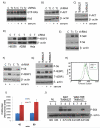Germline mutations in TMEM127 confer susceptibility to pheochromocytoma
- PMID: 20154675
- PMCID: PMC2998199
- DOI: 10.1038/ng.533
Germline mutations in TMEM127 confer susceptibility to pheochromocytoma
Abstract
Pheochromocytomas, which are catecholamine-secreting tumors of neural crest origin, are frequently hereditary. However, the molecular basis of the majority of these tumors is unknown. We identified the transmembrane-encoding gene TMEM127 on chromosome 2q11 as a new pheochromocytoma susceptibility gene. In a cohort of 103 samples, we detected truncating germline TMEM127 mutations in approximately 30% of familial tumors and about 3% of sporadic-appearing pheochromocytomas without a known genetic cause. The wild-type allele was consistently deleted in tumor DNA, suggesting a classic mechanism of tumor suppressor gene inactivation. Pheochromocytomas with mutations in TMEM127 are transcriptionally related to tumors bearing NF1 mutations and, similarly, show hyperphosphorylation of mammalian target of rapamycin (mTOR) effector proteins. Accordingly, in vitro gain-of-function and loss-of-function analyses indicate that TMEM127 is a negative regulator of mTOR. TMEM127 dynamically associates with the endomembrane system and colocalizes with perinuclear (activated) mTOR, suggesting a subcompartmental-specific effect. Our studies identify TMEM127 as a tumor suppressor gene and validate the power of hereditary tumors to elucidate cancer pathogenesis.
Figures




Similar articles
-
Clinical Characterization of the Pheochromocytoma and Paraganglioma Susceptibility Genes SDHA, TMEM127, MAX, and SDHAF2 for Gene-Informed Prevention.JAMA Oncol. 2017 Sep 1;3(9):1204-1212. doi: 10.1001/jamaoncol.2017.0223. JAMA Oncol. 2017. PMID: 28384794 Free PMC article.
-
Spectrum and prevalence of FP/TMEM127 gene mutations in pheochromocytomas and paragangliomas.JAMA. 2010 Dec 15;304(23):2611-9. doi: 10.1001/jama.2010.1830. JAMA. 2010. PMID: 21156949
-
A novel TMEM127 mutation in a patient with familial bilateral pheochromocytoma.Eur J Endocrinol. 2011 Jan;164(1):141-5. doi: 10.1530/EJE-10-0758. Epub 2010 Oct 5. Eur J Endocrinol. 2011. PMID: 20923864
-
Minireview: the busy road to pheochromocytomas and paragangliomas has a new member, TMEM127.Endocrinology. 2011 Jun;152(6):2133-40. doi: 10.1210/en.2011-0052. Epub 2011 Mar 29. Endocrinology. 2011. PMID: 21447639 Review.
-
An update on the genetics of paraganglioma, pheochromocytoma, and associated hereditary syndromes.Horm Metab Res. 2012 May;44(5):328-33. doi: 10.1055/s-0031-1301302. Epub 2012 Feb 10. Horm Metab Res. 2012. PMID: 22328163 Review.
Cited by
-
The Molecular Classification of Pheochromocytomas and Paragangliomas: Discovering the Genomic and Immune Landscape of Metastatic Disease.Endocr Pathol. 2024 Oct 28. doi: 10.1007/s12022-024-09830-3. Online ahead of print. Endocr Pathol. 2024. PMID: 39466488 Review.
-
Molecular Genetics of Pheochromocytoma/Paraganglioma.Curr Opin Endocr Metab Res. 2024 Sep;36:100527. doi: 10.1016/j.coemr.2024.100527. Epub 2024 May 31. Curr Opin Endocr Metab Res. 2024. PMID: 39328362
-
Loss of tumor suppressor TMEM127 drives RET-mediated transformation through disrupted membrane dynamics.Elife. 2024 Apr 30;12:RP89100. doi: 10.7554/eLife.89100. Elife. 2024. PMID: 38687678 Free PMC article.
-
Image-Guided Precision Medicine in the Diagnosis and Treatment of Pheochromocytomas and Paragangliomas.Cancers (Basel). 2023 Sep 21;15(18):4666. doi: 10.3390/cancers15184666. Cancers (Basel). 2023. PMID: 37760633 Free PMC article. Review.
-
TMEM127 suppresses tumor development by promoting RET ubiquitination, positioning, and degradation.Cell Rep. 2023 Sep 26;42(9):113070. doi: 10.1016/j.celrep.2023.113070. Epub 2023 Sep 1. Cell Rep. 2023. PMID: 37659079 Free PMC article.
References
-
- Amar L, et al. Genetic testing in pheochromocytoma or functional paraganglioma. J Clin Oncol. 2005;23:8812–8. - PubMed
-
- Dahia PL. Evolving concepts in pheochromocytoma and paraganglioma. Curr Opin Oncol. 2006;18:1–8. - PubMed
-
- Dahia PLM, et al. Novel Pheochromocytoma Susceptibility Loci Identified by Integrative Genomics. Cancer Res. 2005;65:9651–9658. - PubMed
-
- Sjoblom T, et al. The consensus coding sequences of human breast and colorectal cancers. Science. 2006;314:268–74. - PubMed
-
- Neumann HP, et al. Germ-line mutations in nonsyndromic pheochromocytoma. N Engl J Med. 2002;346:1459–66. - PubMed
Publication types
MeSH terms
Substances
Associated data
- Actions
Grants and funding
LinkOut - more resources
Full Text Sources
Other Literature Sources
Medical
Molecular Biology Databases
Research Materials
Miscellaneous

